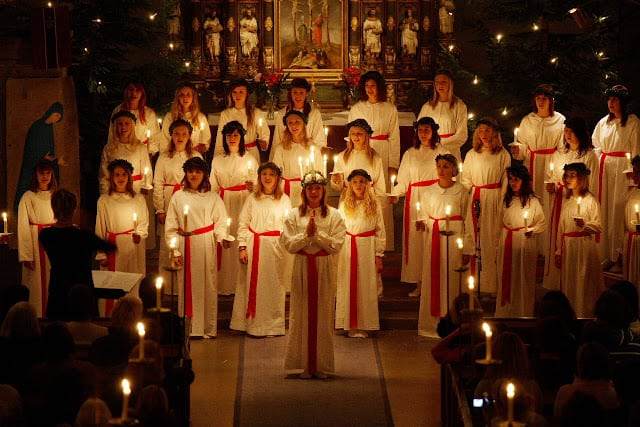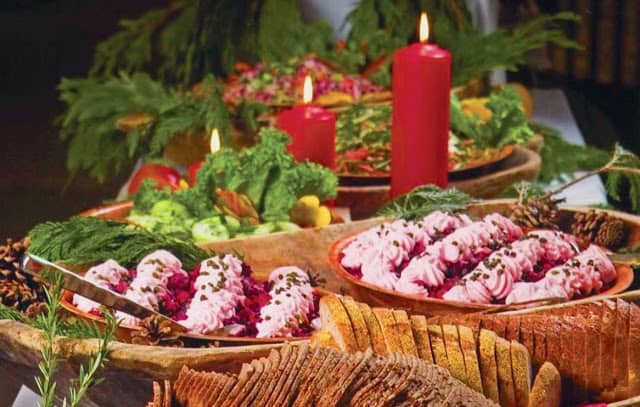St Lucia’s Day is Huge in Sweden
Although like most regions Christmas is an important holiday in Sweden, one of the grandest celebrations is St. Lucia’s Day; (St. Lucy’s Day), and is held on December 13th.
Sweden began to celebrate this holiday beginning in the 1700’s, and is celebrated in other countries of Norway, Bosnia, Croatia, Denmark, and Finland, and Italy.
On this day, they celebrate the stories told by monks who brought Christianity to Sweden. These stories tell of a young Christian girl who was killed for her faith in 304, thus being martyred.
The most popular and common story that is told about Lucia is one about her sneaking food to the Christians who were persecuted in Rome, living in the catacombs under the city.
In order for both hands to remain free to carry items, she would wear candles atop her head; which is appropriate considering that the name Lucy means ‘light’.
(However, the celebrations in Italy are more of a children’s day, and they are told that St Lucia brings them presents. Though not required, some areas will leave out a sandwich for her, and her donkey helper.
Although there are presents that are brought to the children during this celebration, the main gift-giving and exchange of gifts are still done on Christmas; actually, on Christmas Eve.
Celebrations on St Lucia’s Day
Back before Christianity was introduce to Sweden, the 13th of December was not only the Winter Solstice, the shortest day of the year but was also the Pagan festival of lights.
Both of these celebrations have since been turned into what is now St Lucia’s Day, which is celebrated by a girl dressed in white with a red sash around her waist, and adorning a crown of candles.

Although children under the age of 12 use fake candles, real candles are used; the crowns that the children wear are made from Lingonberry branches, which symbolize rebirth.
Additionally, schools will have their own St Lucia’s, and in some towns, the townsfolk will choose a girl to play Lucy in a theatrical procession where carols are sung.
In Sweden, there is also a national Lucia who is chosen; these Lucias will visit hospitals and homes, teaching about St Lucia through song, and giving ‘Pepparkakor’, or ginger snap biscuits.
Another popular food that is consumed on St Lucia’s day is ‘Lussekatts’, or buns with raisins that are seasoned with saffron.
St. Lucia is such an important holiday that sometimes (with the help of their parents), small children will sometimes dress up for the holiday.
For girls, they will, of course, dress up as Lucia (without the candles); while the boys may dress up as ‘Stjarngossar’, or star boys.
Christmas Eve Celebrations in Sweden
Like most regions of the world, Christmas Eve is also a very special and important holiday in Sweden. Although there are smaller feasts and celebrations for St Lucia’s Day, the bulk of these takes place during Christmas Eve.
Unlike customs in other regions of the world, gifts are exchanged on Christmas eve, after the noon feasts.
This is partly due to the fact that at Christmas, many people will attend a church service early in the morning to start the day.
Another thing that many people would not guess that Swedes do on Christmas Eve during the afternoon is to watch Donald Duck on T.V.
This should not seem that odd to people in the western regions of the world, as it seems similar to watching the Charlie Brown Christmas special, that is played for us on TV every year at Christmas time.
It seems to be that regardless of age, these types of traditions are considered to be sacred, and upheld throughout the generations.
This is a custom that has been done every year since 1959, at 3:00 pm.
This is done by around 50% of the Swedish population, and is a Christmas special involving Donald Duck and his friends; the official title is “Kalle Anka och Hans vanner Onkar God Jul”, or “Donald Duck and his friends wish you a Merry Christmas”.
It is interesting to know how people wish Happy or Merry Christmas in other languages.
Christmas Eve Julbord Feast
Referred to as a ‘Julbord’, or buffet, that is consumed in the afternoon.
This is not a potluck, however, and it seems to be that it is only shared among family and close friends.
The people of Sweden are all partial to fish, given their region, and you can expect cold fish to be served at these feasts.
For instance, you shouldn’t be surprised if you see multiple servings of Herring, Gravlax, and smoked Salmon.
Other foods that you can expect to find during these buffets are cold meats such as ham, turkey, and roast beef; as well as an assortment of cheeses, pate, salads, with bread and butter.

Other common foods are comfort foods such as meatballs, sausages, cabbage rolls, lutfisk, and pork ribs; in addition to vegetables as sides, such as potatoes and red cabbage.
Deserts would be a variety of pastries, most of which would be homemade.
Another highly popular food that is served around this time in Sweden is ‘risgrynsgrot’, or rice porridge that is served with raspberry jam. (This is served in the evening, after the exchange of gifts).
Unlike customs in other regions of the world, gifts are exchanged on Christmas eve, after the noon feasts.
All this talk of food is making me hungry! To wash all of these delicious foods down, the people of Sweden consume what is called ‘glogg’, or sweet mulled wine; or some coffee.
Tomten and Connection with Santa Clause
Although there is still a figure that could be attributed to Santa Clause, it is known more as ‘Jultomten’ or simply ‘Tomten’, which translated roughly means “The Christmas Gnome”. Much like in western customs, he is assisted by elves or gnomes, called ‘Nissor’.
Although this Christmas gnome does not have a jolly laugh or is the usual portrayal of Santa Clause, the basic belief still stands that he is the one responsible for bringing gifts and cheer to the children of Sweden on Christmas.

The end of the Christmas celebrations in Sweden is 12 days after Christmas or January 13th. This is called “Tjugondag Knut’, or Twentieth Day Knut, and its namesake is from a Danish prince called Canute Lavard.
On this day, it is traditional that the Christmas trees are taken down, and all leftover treats are consumed.
As in other areas of the world, the nativity with the baby Jesus plays a big role, and there are many celebrations that are built around this; and this is especially true ever since Christianity was brought to Sweden as the main religious belief system.
Significance of Goats
Going more on the traditional side, and similar to their neighbors in Finland, many Swedes believe that a Yule Goat was connected to the mid-winter festival.
This goat was thought to be an invisible spirit that looked overall preparations to make sure that everything was running smoothly.
The period of time that is between Christmas and New Year is when some med around villages and settlements would go around dressed as goat singing carols and performing pranks; this is called ‘Julebukking’, and there is no known translation in English.
This goat primarily appears as a straw ornament that protects houses and Christmas trees.
The straw is used as a reminder of baby Jesus in the manger, and Christmas tree decorations that are made from straw are also widely popular.
Although there are some customs that have been forgotten with the arrival of Christianity to Sweden, as in the case of the spirit of the goat, there are some traditions that still remain, and have shown to have significant value to the Swedes.
There are no ties to Paganism with the goat, as some people from the west may assume.
The Goat of Gavle
Beginning in 1966, and going now to the establishment of Gavle, every year a giant straw goat is constructed and erected to mark the start of the yearly celebrations; it is so massive that it takes two days to assemble.
At its core, it is a metal structure that is then covered in straw.
However, this structure has only made it through Christmas and New Year’s for a record of 12 times; this is due to the fact that from its first year in conception, it has been a target for vandals, who tend to burn it to the ground; in its 50th year only surviving for 2 days before being set aflame.

Although not enforced, it seems to be that the burning of the massive goat made of straw has become another tradition for the people of Sweden, and it is just assumed that it won’t last long until it is set on fire.
This can be seen in other parts of the world, as well; such as in the case of the burning man festival that is in the states.
Learn More With the Help of Video
Main Points About Christmas in Sweden
- Christmas preparations in Sweden start towards the end of November.
- Some of the common activities that lead up to Christmas include a deep cleaning of family homes, big shopping for food and drinks, hanging of Christmas decorations and setting up the Christmas tree, wrapping presents, baking, and cooking, etc.
- On Christmas eve, a buffet (julbord) is eaten at lunchtime. The dishes include cold fish, herring, gravlax, smoked salmon, turkey, julskinka, cheese, salad, pickles, meatballs, vegetables, potatoes, ham and so much more.
- Commonly, there is an exchange of gifts on Christmas eve.
- Every Christmas, a yule goat is built with straw and burnt.
Conclusion
In Sweden Christmas is celebrated on the 24th – that’s also when Santa will come to the house and hand out presents for the children and sometimes also for the adults!
Typically you will have ham in different versions for breakfast, lunch, and dinner, lots of meatballs and of course lots of sweets and gingerbread.
The 25th is a calm day until the evening comes and all young people go out to the party.
Word Cloud for Christmas in Sweden
The following is a collection of the most used terms in this article on Christmas in Sweden. This should help in recalling related terms as used in this article at a later stage for you.




